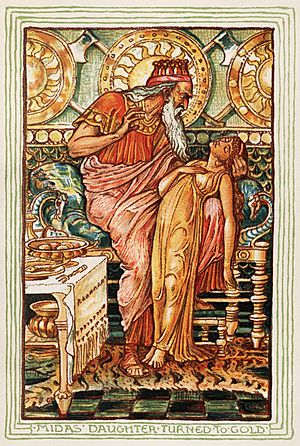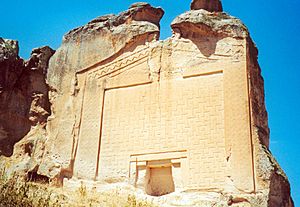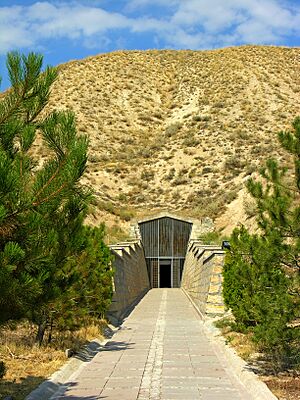Midas facts for kids
Midas was a famous king from an ancient land called Phrygia. He is best known in Greek mythology for his amazing ability to turn everything he touched into pure gold. This special power was often called the golden touch or the Midas touch.
Midas's father was Gordias, and his mother was Cybele. Legends say that Midas and his adopted father, Gordias, lived a very long time ago, even before the famous Trojan War. Gordias is also known for founding the Phrygian capital city, Gordium, and for tying the famous Gordian Knot.
There were other kings named Midas in Phrygia later on. One ruled in the late 700s BC. Another Midas was part of the royal family in the 500s BC.
Contents
The Myth of King Midas
There are many old stories about King Midas, and sometimes they don't all agree. In one story, Midas was a king in a Phrygian city called Pessinus. As a child, he was adopted by King Gordias and the goddess Cybele. Some stories say Midas grew up in a place called Bermion in Macedon. The ancient writer Herodotus even mentioned a beautiful rose garden there, saying it was "the garden of Midas." This suggests Midas lived before the Phrygians moved to Asia.
Some myths say Midas had a son named Lityerses, who was known as a "reaper of men." Other stories mention a son named Anchurus.
Another tale about Midas's rise to power comes from the writer Arrian. He said Midas was the son of a poor farmer and a maiden who could see the future. The people of Phrygia were having many problems and asked an oracle for help. The oracle told them that a wagon would bring them a king who would solve their problems. Soon after, Midas arrived with his parents in a wagon. The people believed he was the king the oracle spoke of. They made Midas their king, and he brought peace to the land. He then dedicated his father's wagon to the god Zeus. There was also a saying that whoever could untie the knot on this wagon's yoke would rule all of Asia. This was later said to be Alexander the Great.
Herodotus also wrote that a "Midas, son of Gordias," gave a royal throne to the Oracle of Delphi. This throne was used for making judgments and was "well worth seeing." Herodotus said Midas was the first foreigner to give such a gift to Delphi. Many historians think this Midas was the legendary king, not a later historical one.
The Golden Touch
One day, the god Dionysus found that his old teacher, a satyr named Silenus, was missing. Silenus had been drinking wine and was found by some farmers. They brought him to King Midas. Midas recognized Silenus and treated him very kindly. He entertained Silenus for ten days and nights with stories and songs.
On the eleventh day, Midas took Silenus back to Dionysus. Dionysus was so grateful that he offered Midas any reward he wished for. Midas thought for a moment and then asked for a special power: that everything he touched would turn into pure gold.
Midas was thrilled with his new power. He quickly tested it. He touched an oak branch and a stone, and both instantly turned to gold. When he got home, he touched every rose in his garden, and they all became golden. He then asked his servants to prepare a feast. But as he tried to eat and drink, the food and water also turned to gold in his hands. Midas quickly regretted his wish and cursed it.
In a version of the story by Nathaniel Hawthorne, Midas's daughter came to him, sad that the roses had lost their smell and become hard. When Midas reached out to comfort her, he accidentally touched her, and she also turned into a golden statue. Midas now truly hated his gift. He prayed to Dionysus, begging to be freed from this curse and from starvation.
Dionysus heard his prayer and agreed to help. He told Midas to wash in the Pactolus river. Whatever Midas put into the water would lose the golden touch. Midas did as he was told. When he touched the river, his power flowed into the water, and the river's sands turned to gold. This is why the Pactolus river was said to be rich in gold.
However, some stories, like the one by Aristotle, say that Midas eventually died of starvation because his "vain prayer" for gold was never fully lifted.
The Ears of a Donkey
After his experience with the golden touch, Midas began to dislike wealth. He moved to the countryside and became a follower of Pan, the god of fields and forests.
One day, Pan dared to compare his music with that of Apollo, the god of music. Pan challenged Apollo to a music contest. Tmolus, a mountain god, was chosen to be the judge. Pan played his pipes, and his simple melody pleased him and his loyal follower, Midas, who was there. Then Apollo played his lyre. Tmolus immediately declared Apollo the winner. Everyone agreed, except for Midas. He questioned the fairness of the decision.
Apollo was angry that Midas had such poor judgment. He said, "You must have the ears of an ass!" (meaning a donkey). Right away, Midas's ears turned into long, furry donkey ears. Midas was very embarrassed. He tried to hide his new ears under a large turban. Only his barber knew the secret. Midas told the barber not to tell anyone.
But the barber couldn't keep the secret to himself. He went to a meadow, dug a hole in the ground, whispered the story into it, and then covered the hole. Later, a bed of reeds grew from that spot. When the wind blew through them, the reeds began to whisper the secret: "King Midas has an ass's ears!"
Possible Tomb of Midas
In 1957, a team of archaeologists led by Rodney Young explored a large burial mound at the ancient site of Gordion in Turkey. This mound, called Tumulus MM (for "Midas Mound"), was huge, about 53 meters high. Inside, they found a royal burial chamber. The wood used in the tomb was cut around 740 BC. They found the remains of a funeral feast and many ancient drinking cups.
The tomb contained the skeleton of a man about 60 years old. They also found beautiful inlaid tables, serving stands, and many bronze and pottery items. While there were no writings to identify the person, it's generally thought that this tomb belonged to Midas's father, not Midas himself, because of the date it was built.
See also
 In Spanish: Midas para niños
In Spanish: Midas para niños
- Philosopher's stone, a mythical object in old stories that could turn ordinary metals into gold.
- The Golden Touch, a Walt Disney cartoon based on the King Midas myth.
- The Chocolate Touch, a children's book about a boy who turns everything he touches into chocolate.





